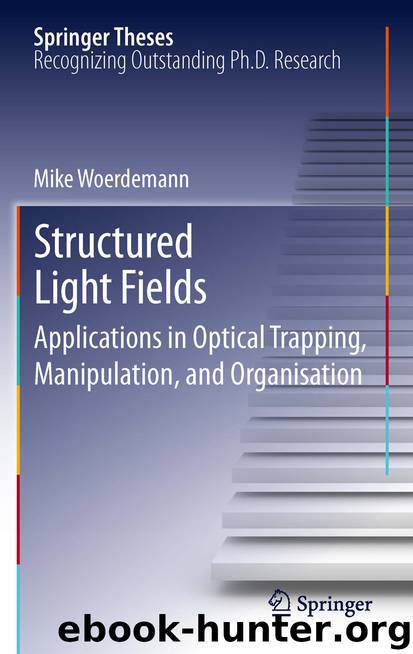Structured Light Fields by Mike Wördemann

Author:Mike Wördemann
Language: eng
Format: epub
Publisher: Springer Berlin Heidelberg, Berlin, Heidelberg
4.5 Conclusion and Perspectives
The resulting system is somewhat complex from the physical point of view. It is, for example, not trivial and highly interesting how the particle interacts with the light field. In the case of an infinitesimally small particle, we can safely assume that the incident light field is unaltered and reflected by the PCM as illustrated in Fig. 4.4b. A particle of a few micrometers on the other hand certainly does interact with the incident light field by scattering. Possible consequences are that not all scattered light might be recollected after passing through the particle and the light field that reaches the PCM is additionally modified, e. g. by focusing effects of the particle. Furthermore, the particle is not still, even if it is not translated intentionally, but vibrates in the trap because of Brownian motion. The power spectrum of this vibration (depending on the trap stiffness and temperature; cf. Sect. 2.5) yields characteristic time constants that can be compared to In the discussed implementation, the PCM has time constants in the order of seconds which is very large compared to typical values of . Hence, the PCM reflects an averaged light field.
The response time of the PCM also limits the maximal possible velocity with which a particle can be translated. With the current setup, velocities up to about are accessible. The chosen photorefractive implementation of a PCM is not only known for its high fidelity and the low required light intensities, but also has a very long response time compared to most other ways to realise optical PC (He 2002). It thus should be easy to decrease the time constant by many orders of magnitude. Then, the PCM is no longer the limiting factor in translation speed, but other factors, like the available optical force and the viscosity of the medium that surrounds the particle become dominant.
Many applications of optical traps involve the trapping of biological cells. The demonstrated setup uses green () light, which is a good choice for the manipulation of artificial objects, but causes serious photodamage in living cells. Better suited wavelengths are in the near infrared (NIR), with 830 and 970 nm being optimal in many cases (Neuman et al. 1999). It should be straightforward to extend the presented concept to NIR wavelengths, as there are photorefractive materials available that provide high reflectivity in this wavelength regime (e. g. cobalt-doped (Rytz et al. 1990)).
In summary, it was demonstrated that CP optical traps which utilise optical PC can be a versatile tool in optical micromanipulation. On the one hand, they inherit most desired features, in particular low possible numerical apertures and thus high working distances, increased axial symmetry of the optical potentials and reduced intensities compared to single beam optical tweezers. On the other hand, they are self-aligning and adapt automatically to any arbitrary input trap configuration. The basic concept of a single CP trap has been developed towards multiple, dynamic traps, paving the way towards advanced applications. The dynamic capabilities include reconfigurable traps and three-dimensional translation of the trapped particles in real-time.
Download
This site does not store any files on its server. We only index and link to content provided by other sites. Please contact the content providers to delete copyright contents if any and email us, we'll remove relevant links or contents immediately.
| Cell Biology | Developmental Biology |
| Entomology | Marine Biology |
| Microbiology | Molecular Biology |
| Biostatistics |
Sapiens: A Brief History of Humankind by Yuval Noah Harari(14322)
The Tidewater Tales by John Barth(12627)
Mastermind: How to Think Like Sherlock Holmes by Maria Konnikova(7281)
Do No Harm Stories of Life, Death and Brain Surgery by Henry Marsh(6908)
The Thirst by Nesbo Jo(6882)
Why We Sleep: Unlocking the Power of Sleep and Dreams by Matthew Walker(6659)
Life 3.0: Being Human in the Age of Artificial Intelligence by Tegmark Max(5519)
Sapiens by Yuval Noah Harari(5325)
The Longevity Diet by Valter Longo(5044)
The Body: A Guide for Occupants by Bill Bryson(5033)
The Rules Do Not Apply by Ariel Levy(4912)
The Immortal Life of Henrietta Lacks by Rebecca Skloot(4552)
Animal Frequency by Melissa Alvarez(4430)
Why We Sleep by Matthew Walker(4395)
The Hacking of the American Mind by Robert H. Lustig(4342)
Yoga Anatomy by Kaminoff Leslie(4334)
All Creatures Great and Small by James Herriot(4277)
Double Down (Diary of a Wimpy Kid Book 11) by Jeff Kinney(4244)
Embedded Programming with Modern C++ Cookbook by Igor Viarheichyk(4143)
